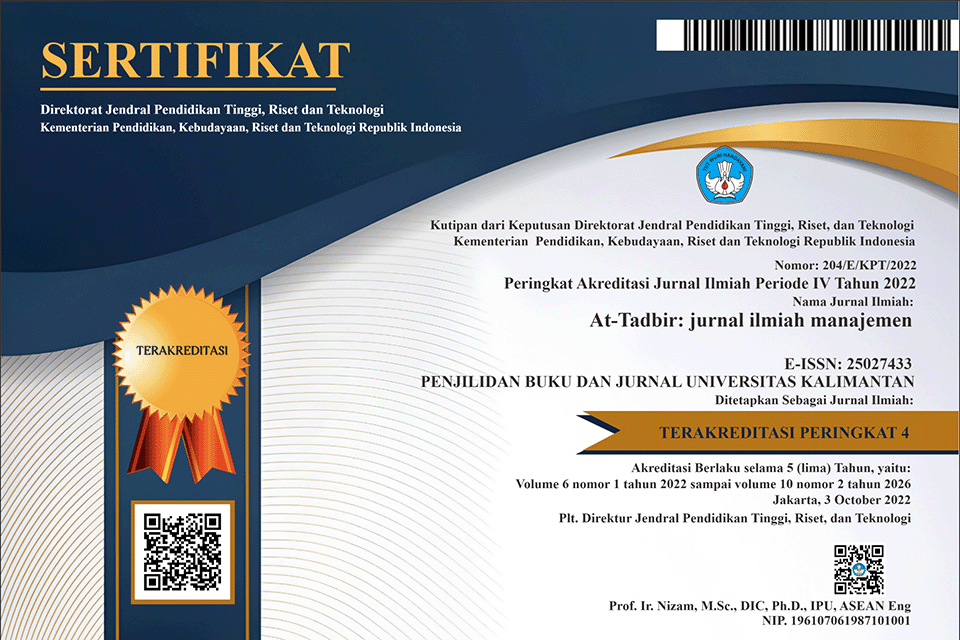Efektivitas Transmisi Kebijakan Moneter Melalui Jalur Kredit Perbankan Dan Harga Aset Dalam Sasaran Akhir Inflasi
(1) Universitas Muhammadiyah Malang
(*) Corresponding Author
Abstract
Transmisi kebijakan moneter mempunyai peranan penting dalam mengendalikan inflasi di Indonesia. Peranan saluran kredit dan harga aset dalam transmisi kebijakan moneter dapat mempengaruhi kegiatan bisnis dan aktivitas ekonomi. Fungsi dari saluran kredit dan harga aset sebagai perantara kebijakan moneter untuk mengontrol dan meminimalisir ketidaksempurnaan informasi, kemungkinan terjadinya penyelewengan, dan adverse selection. Tujuan dari penelitian ini adalah menjelaskan peran dari saluran kredit dan harga aset dalam berkontribusi terhadap inflasi dalam jangka panjang. Penelitian ini menggunakan metode VECM. Dalam penelitian ini membuktikan bahwa variabel BI7DayRR, kredit investasi, kredit modal kerja, IHSG dan DPK berpengaruh signifikan dalam jangka panjang.
Full Text:
PDFReferences
Abou, E.-S. M. S. (2014). Testing the relationship between money supply and GDP in Bahrain. International Journal of Economics, Commerce and Management, II(5), 1–16.
Agung, J. (1998). Financial deregulation and the bank lending channel in developing countries: The case of Indonesia. Asian Economic Journal, 12(3), 273–294. https://doi.org/10.1111/1467-8381.00063
Aleem, A. (2010). Transmission mechanism of monetary policy in India. Journal of Asian Economics, 21(2), 186–197. https://doi.org/10.1016/j.asieco.2009.10.001
Astuti, R. D., & Hastuti, S. R. B. (2020). Transmisi Kebijakan Moneter Di Indonesia. JEQu, 10(1), 1–22.
Bjørnland, H. C., & Jacobsen, D. H. (2013). House Prices and Stock Prices: Different Roles in the US Monetary Transmission Mechanism. Scandinavian Journal of Economics, 115(4), 1084–1106. https://doi.org/10.1111/sjoe.12031
Bonomo, M., & Martins, B. (2016). The Impact of Government-Driven Loans in the Monetary Transmission Mechanism: what can we learn from firm-level data? 30. http://www.bcb.gov.br/pec/wps/ingl/wps419.pdf
Can, U., Bocuoglu, M. E., & Can, Z. G. (2020). How does the monetary transmission mechanism work? Evidence from Turkey. Borsa Istanbul Review, 20(4), 375–382. https://doi.org/10.1016/j.bir.2020.05.004
Chaudhry, I. S., Qamber, Y., & Farooq, F. (2012). Monetary policy, inflation and economic growth in Pakistan: exploring the co-integration and causality relationships. Pakistan Journal of Commerce and Social Sciences, 6(2), 332–347.
Fan, Y., & Jianzhou, T. (2011). Studying on the monetary transmission mechanism in China in the presence of structural changes. China Finance Review International, 1(4), 334–357.
Fungáčová, Z., Nuutilainen, R., & Weill, L. (2016). Reserve requirements and the bank lending channel in China. In Journal of Macroeconomics (Vol. 50). https://doi.org/10.1016/j.jmacro.2016.08.007
Hafidh, A. A. (2021). Responses of Islamic banking variables to monetary policy shocks in Indonesia. Islamic Economic Studies, 28(2), 174–190. https://doi.org/10.1108/IES-11-2020-0049
Hussain, M., Bashir, U., & Bilal, A. R. (2020). Effect of monetary policy on bank risk: does market structure matter? International Journal of Emerging Markets, 16(4), 696–725. https://doi.org/10.1108/IJOEM-09-2019-0674
Ishioro, B. O. (2013). Monetary transmission mechanism in Nigeria: A causality test. Mediterranean Journal of Social Sciences, 4(13), 377–388. https://doi.org/10.5901/mjss.2013.v4n13p377
Kassim, S., & A. Majid, M. S. (2009). The Role of Bank Loans and Deposits in the Monetary Transmission Mechanism In Malaysia. The International Journal of Banking and Finance, 6, 37–59. https://doi.org/10.32890/ijbf2009.6.2.8388
Le Viet, H., & Pfau, W. D. (2008). Var analysis of the monetary transmission mechanism in Vietnam. Applied Econometrics and International Development, 9(1), 165–179.
Liu, X. Z. S. (2016). Research on the Transmission Mechanism between the Money Market Interest Rates and the Capital Market Interest Rates. China Finance Review International, 6(2).
Mahara, T. S. (2020). Money Supply-Economic Growth Nexus: Evidence from a Landlocked Country. Quest Journal of Management and Social Sciences, 2(1), 106–115. https://doi.org/10.3126/qjmss.v2i1.29026
Marshal, I. (2016). The link between money supply and economic growth in Nigeria: an econometric investigation. International Journal of Economics and Business Management, 2, 42–51.
Mayo, R., Maskie, G., & Pratomo, D. S. (2014). Efektivitas Jalur Kredit dalam Mekanisme Transmisi Kebijakan Moneter di Indonesia. Jurnal Keuangan Dan Perbanakan, 18(1), 152–160.
Michael, A., Owusu Oppong, E., & Gulnabat, O. (2020). Effects of Monetary Policy on Economic Growth; Evidence from Five (5) African Countries (Mauritius, Nigeria, South Africa, Namibia and Kenya) from 1980 to 2019. Scholars Journal of Economics, Business and Management, 7(9), 293–298. https://doi.org/10.36347/sjebm.2020.v07i09.002
Pradhan, R. P., Arvin, M. B., & Bahmani, S. (2015). Causal nexus between economic growth, inflation, and stock market development: The case of OECD countries. Global Finance Journal, 27, 98–111. https://doi.org/10.1016/j.gfj.2015.04.006
Sun, L., Ford, J. L., & Dickinson, D. G. (2010). Bank loans and the effects of monetary policy in China: VAR/VECM approach. China Economic Review, 21(1), 65–97. https://doi.org/10.1016/j.chieco.2009.11.002
Warjiyo, P., & Juhro, S. (2017). Kebijakan Bank Sentral Teori dan Praktek (1st ed.). Rajawali Pers.
Wulandari, R. (2012). Do Credit Channel and Interest Rate Channel Play Important Role in Monetary Transmission Mechanism in Indonesia?: A Structural Vector Autoregression Model. Procedia - Social and Behavioral Sciences, 65, 557–563. https://doi.org/10.1016/j.sbspro.2012.11.165
DOI: http://dx.doi.org/10.31602/atd.v6i2.6897
Refbacks
- There are currently no refbacks.
Copyright (c) 2022 Muhammad Firmansyah
---------------------------------------------------------------------------------------------------------------------
At-Tadbir: Jurnal Ilmiah Manajemen is licensed under Creative Commons Attribution-Share A like 4.0 International License




